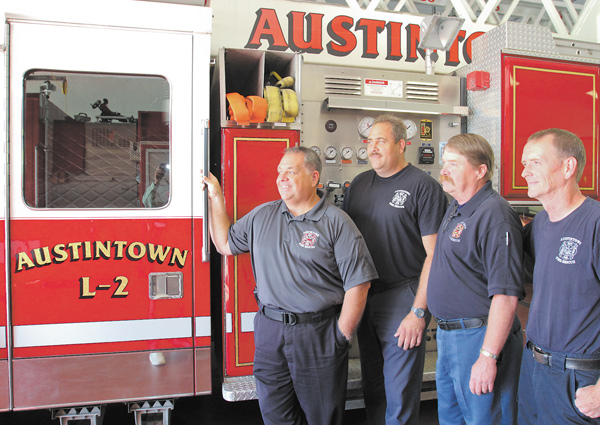Austintown Fire Department celebrates 75 years


The Austintown Fire Department was established in 1938. Current members include, from left, Andrew Frost III, fire chief; firefighter Tom Neff ; Bob Williams, assistant fire chief; and Capt. Dan Martin.
By kalea hall
Austintown
Austintown Fire Chief Andrew Frost III still gets goosebumps when he remembers the day a building almost collapsed on firefighters, including himself.
Likewise, his father, Andrew Frost Jr., the former chief, remembers that day as one of the scariest moments he had in 46 years with the department.
The 2006 Youngstown Steel Door Industries collapse is just one of the moments making up the 75 years the Austintown Fire Department has been serving the community and making changes to grow with the population.
“Basically, the call volume and volunteerism has dictated the direction of the fire department,” the younger Frost said. “We have to provide a service, and we have to provide properly. And when something starts failing and you cannot provide that service, then you have to make changes.”
The Austintown Fire Department was established in May 1938 with only volunteer firefighters. It did not acquire a firetruck until June 28, 1939, when it bought one with a grant for $8,040. By comparison, a new fire pumper similar to the department’s first pumper truck costs $335,000.
On Aug. 1, 1939, the department answered its first call for a car fire at Shovani’s Grocery Store on Mahoning Avenue. The department has since moved out of the first fire station on Mahoning Avenue, and has gone from volunteer to a combination of full-time employees, part-timers and volunteers.
“Today we have a lot more full-time firemen, and we actually reduced the amount of volunteers because it is hard to get people this day and age,” the chief said.
The elder Frost was the first full-time firefighter hired in 1980. He started with the department in 1966 while he worked at General Motors. After rising through the ranks he became chief in 1985.
“We have done nothing but grow since then and build buildings and remodel buildings and get new trucks,” the elder Frost said.
When the steel mills were running, the firefighting business in Austintown was quite different from today. With a majority of volunteers, there were fewer stations and the call volume was much lower. In the past the department might have received 70 calls a year, but as the population grew with the mills, so did the calls. Today, the department answers 2,500 calls a year. In 1992, the department became a full-time department, staffed 24 hours a day.
“It was actually a huge deal,” the younger Frost said. “We were just able to provide a service so much quicker.”
The department now has one tower truck, two ladder trucks and five engine trucks with four stations, two of which are not manned 24 hours a day; 20 full-time firefighters, 35 volunteers and three full-time fire inspectors.
“There were three full-time employees when he first started,” the younger Frost said.
The chief had no intent to become a firefighter. He studied computer science in college. Now, sitting in his office, he is happy he stayed to take over for his father, who retired in 2012.
The goal for the department’s future is just to grow when necessary. The current budget of about $3 million a year does not give the department much growing room, he said, but as of now the department is stable.
Tom Neff, a firefighter and arson investigator, is dedicated to preserving the history of the department including memories of the collapse, the only fatality in the department, and the largest fire the department has fought.
“I just hate to lose all of that history,” Neff said.
Ewing Creed, 34, a volunteer captain, was killed after he was electrocuted while trying to save a man who was being shocked by hot wires. The largest fire the department fought was in August 1998 at the Century 21 paint store on Meridian Road. Firefighters from Austintown and other area departments fought the flames for days.
“That was one that just taxed our whole area,” the chief said.
 43
43
